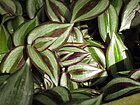Note: This is a project under development. The articles on this wiki are just being initiated and broadly incomplete. You can Help creating new pages.
Difference between revisions of "Tradescantia pallida - Wandering jew"
(→Commonly seen growing in areas) |
|||
| Line 57: | Line 57: | ||
==Commonly seen growing in areas== | ==Commonly seen growing in areas== | ||
| − | {{Commonly seen| | + | {{Commonly seen|weed of waste areas}}, {{Commonly seen|disturbed sites}}, {{Commonly seen|roadsides}}, {{Commonly seen|bushland}}. |
==Photo Gallery== | ==Photo Gallery== | ||
Revision as of 12:15, 12 June 2018
Tradescantia pallida is native to the Gulf Coast region of eastern Mexico. Edward Palmer was the first European to observe and assign a Latin name to the type specimen near Ciudad Victoria, Tamaulipas in 1907.
Contents
- 1 Uses
- 2 Parts Used
- 3 Chemical Composition
- 4 Common names
- 5 Properties
- 6 Habit
- 7 Identification
- 8 List of Ayurvedic medicine in which the herb is used
- 9 Where to get the saplings
- 10 Mode of Propagation
- 11 How to plant/cultivate
- 12 Commonly seen growing in areas
- 13 Photo Gallery
- 14 References
- 15 External Links
Uses
common cold, hypertension, tuberculosis, uterine disorders, high blood pressure, coughs, amenorrhea, hemorrhoids, kidney problems
Parts Used
Chemical Composition
ß-sitosterol, 3β, 5α, 6β-trihydroxy stigmast and succinic acid, ß-sitosterol, 3ß, 5a, 6ß-trihydroxystigmast and succinic acid[1]
Common names
| Language | Common name |
|---|---|
| Kannada | |
| Hindi | |
| Malayalam | |
| Tamil | |
| Telugu | |
| Marathi | NA |
| Gujarathi | NA |
| Punjabi | NA |
| Kashmiri | NA |
| Sanskrit | |
| English | Purple heart, Wandering Jew |
Properties
Reference: Dravya - Substance, Rasa - Taste, Guna - Qualities, Veerya - Potency, Vipaka - Post-digesion effect, Karma - Pharmacological activity, Prabhava - Therepeutics.
Dravya
Rasa
Tikta (Bitter), Kashaya (Astringent)
Guna
Laghu (Light), Ruksha (Dry), Tikshna (Sharp)
Veerya
Ushna (Hot)
Vipaka
Katu (Pungent)
Karma
Kapha, Vata
Prabhava
Habit
Identification
Leaf
| Kind | Shape | Feature |
|---|---|---|
| Simple | Alternate | The leaves are Broadly spear shaped, 20-80 mm long x 10-30 mm wide, shiny, hairless apart from a few fine hairs at the base |
Flower
| Type | Size | Color and composition | Stamen | More information |
|---|---|---|---|---|
| Bisexual | 2-4cm long | Yellow | 5-6 | Flowers are Radially symmetrical (actinomorphic). No stalks. Terminal clusters. Without nectar. Wind pollinated |
Fruit
| Type | Size | Mass | Appearance | Seeds | More information |
|---|---|---|---|---|---|
| Capsule | 7–10 mm | clearly grooved lengthwise, Lowest hooked hairs aligned towards crown | Small | {{{6}}} |
Other features
List of Ayurvedic medicine in which the herb is used
- Vishatinduka Taila as root juice extract
Where to get the saplings
Mode of Propagation
How to plant/cultivate
Grow in all-purpose potting mix in either a pot or hanging basket[3]
Commonly seen growing in areas
weed of waste areas, disturbed sites, roadsides, bushland.
Photo Gallery
References
External Links
- Ayurvedic Herbs known to be helpful to treat common cold
- Ayurvedic Herbs known to be helpful to treat hypertension
- Ayurvedic Herbs known to be helpful to treat tuberculosis
- Ayurvedic Herbs known to be helpful to treat uterine disorders
- Ayurvedic Herbs known to be helpful to treat high blood pressure
- Ayurvedic Herbs known to be helpful to treat coughs
- Ayurvedic Herbs known to be helpful to treat amenorrhea
- Ayurvedic Herbs known to be helpful to treat hemorrhoids
- Ayurvedic Herbs known to be helpful to treat kidney problems
- Herbs with Leaves used in medicine
- Herbs with Stems used in medicine
- Herbs with common name in English
- Habit - Herb
- Index of Plants which can be propagated by Seeds
- Index of Plants which can be propagated by Cuttings
- Herbs that are commonly seen in the region of weed of waste areas
- Herbs that are commonly seen in the region of disturbed sites
- Herbs that are commonly seen in the region of roadsides
- Herbs that are commonly seen in the region of bushland
- Herbs




